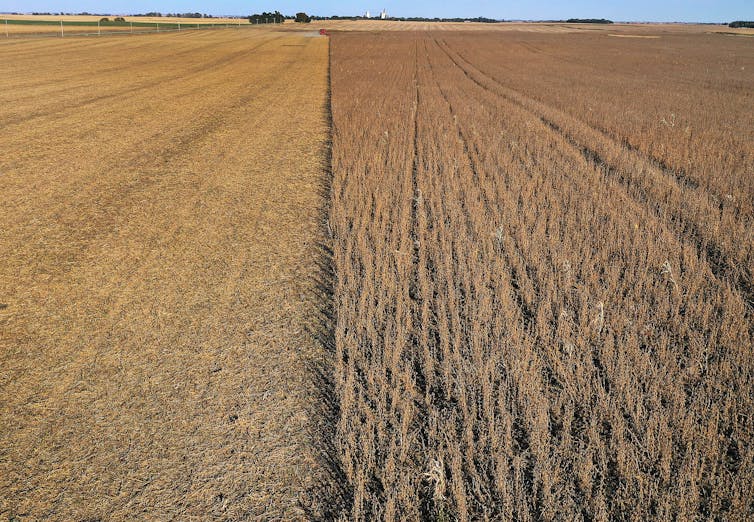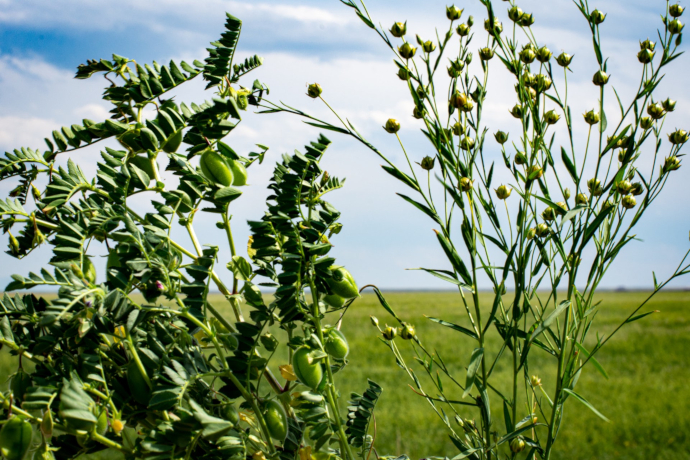Chick peas intercropped with flax on a farm in Stanford, Montana. USDA NRCS Montana photo.
Computer science can help farmers explore
alternative crops and sustainable methods
by Barath Raghavan, University of Southern California and Michael Kantar, University of Hawaii
Humans have physically reconfigured half of the world’s land to grow just eight staple crops: maize (corn), soy, wheat, rice, cassava, sorghum, sweet potato and potato. They account for the vast majority of calories that people around the world consume. As global population rises, there’s pressure to expand production even further.
Many experts argue that further expanding modern industrialized agriculture – which relies heavily on synthetic fertilizer, chemical pesticides and high-yield seeds – isn’t the right way to feed a growing world population. In their view, this approach isn’t sustainable ecologically or economically, and farmers and scientists alike feel trapped within this system.
Corn’s evolution into a global commodity shows how industrialized agriculture has transformed farming.
How can societies develop a food system that meets their needs and is also more healthy and diverse? It has proved hard to scale up alternative methods, such as organic farming, as broadly as industrial agriculture.
In a recent study, we considered this problem from our perspectives as a computer scientist and a crop scientist. We and our colleagues Bryan Runck, Adam Streed, Diane R. Wang and Patrick M. Ewing proposed a way to rethink how agricultural systems are designed and implemented, using a central idea from computer science – abstraction – that summarizes data and concepts and organizes them computationally, so we can analyze and act upon them without having to constantly examine their internal details.
Big output, big impacts
Modern agriculture intensified over just a few decades in the mid-20th century – a blink of an eye in human history. Technological improvements led the way, including the development of synthetic fertilizer and statistical methods that improved plant breeding.
These advances made it possible for farms to produce much larger quantities of food, but at the expense of the environment. Large-scale agriculture has helped drive climate change, polluted lakes and bays with nutrient runoff and accelerated species losses by turning natural landscapes into monoculture crop fields.
Many US farmers and agricultural researchers would like to grow a wider range of crops and use more sustainable farming methods. But it’s hard for them to figure out what new systems could perform well, especially in a changing climate. Lower-impact farming systems often require deep local knowledge, plus an encyclopedic understanding of plants, weather and climate modeling, geology and more.
That’s where our new approach comes in.

Monoculture farming, like this Iowa soybean field shown during harvest, has contributed to the decline
of bees and other pollinators by reducing their food sources. Joe Raedle/Getty Images
Farms as state spaces
When computer scientists think about complex problems, they often use a concept called a state space. This approach mathematically represents all of the possible ways in which a system can be configured. Moving through the space entails making choices, and those choices change the state of the system, for better or worse.
As an example, consider a game of chess with a board and two players. Each configuration of the board at a moment in time is a single state of the game. When a player makes a move, it shifts the game to another state.
The whole game can be described by its “state space” – all possible states the game could be in through valid moves the players make. During the game, each player is searching for states that are better for them.
We can think of an agricultural system as a state space in a particular ecosystem. A farm and its layout of plant species at any moment in time represent one state in that state space. The farmer is searching for better states and trying to avoid bad ones.
Both humans and nature shift the farm from one state to another. On any given day, the farmer might do a dozen different things on the land, such as tilling, planting, weeding, harvesting or adding fertilizer. Nature causes minor state transitions, such as plants growing and rain falling, and much more dramatic state transitions during natural disasters such as floods or wildfires.
Climate change is altering the zones in which major crops like corn and wheat can be grown, reducing yields in some cases and increasing them in others.
Finding synergies
Viewing an agricultural system as a state space makes it possible to broaden choices for farmers beyond the limited options today’s farming systems offer.
Individual farmers don’t have the time or ability to do trial and error for years on their land. But a computing system can draw on agricultural knowledge from many different environments and schools of thought to play a metaphorical chess game with nature that helps farmers identify the best options for their land.
Conventional agriculture limits farmers to a few choices of plant species, farming methods and inputs. Our framework makes it possible to consider higher-level strategies, such as growing multiple crops together or finding management techniques that are best suited to a particular piece of land. Users can search the state space to consider what mix of methods, species and locales could achieve those goals.
For example, if a scientist wants to test five crop rotations – raising planned sequences of crops on the same fields – that each last four years, growing seven plant species, that represents 721 potential rotations. Our approach could use information from long-term ecological research to help find the best potential systems to test.
One area where we see great potential is intercropping – growing different plants in a mixture or close together. Many combinations of specific plants have long been known to grow well together, with each plant helping the others in some way.
The most familiar example is the “three sisters” – maize, squash and beans – developed by Indigenous farmers of the Americas. Corn stalks act as trellises for climbing bean vines, while squash leaves shade the ground, keeping it moist and preventing weeds from sprouting. Bacteria on the bean plants’ roots provide nitrogen, an essential nutrient, to all three plants.
Cultures throughout human history have had their own favored intercropping systems with similar synergies, such as tumeric and mango or millet, cowpea and ziziphus, commonly known as red date. And new work on agrivoltaics shows that combining solar panels and farming can work surprisingly well: The panels partially shade crops that grow underneath them, and farmers earn extra income by producing renewable energy on their land.
Modeling alternative farm strategies
We are working to turn our framework into software that people can use to model agriculture as state spaces. The goal is to enable users to consider alternative designs based upon their intuition, minimizing the costly trial and error that’s now required to test out new ideas in farming.
Today’s approaches largely model and pursue optimizations of existing, often unsustainable systems of agriculture. Our framework enables discovery of new systems of agriculture and then optimization within those new systems.
Users also will be able to specify their objectives to an artificial intelligence-based agent that can perform a search of the farm state space, just as it might search the state space of a chessboard to pick winning moves.
Modern societies have access to many more plant species and much more information about how different species and environments interact than they did a century ago. In our view, agricultural systems aren’t doing enough to leverage all that knowledge. Combining it computationally could help make agriculture more productive, healthy and sustainable in a rapidly changing world.![]()
Barath Raghavan, Associate Professor of Computer Science and Electrical and Computer Engineering, University of Southern California and Michael Kantar, Associate Professor of Tropical Plants & Soil Sciences, University of Hawaii
This article is republished from The Conversation under a Creative Commons license. Read the original article.
Contact us by email at fund4thepanamanews@gmail.com
To fend off hackers, organized trolls and other online vandalism, our website comments feature is switched off. Instead, come to our Facebook page to join in the discussion.
These links are interactive — click on the boxes












